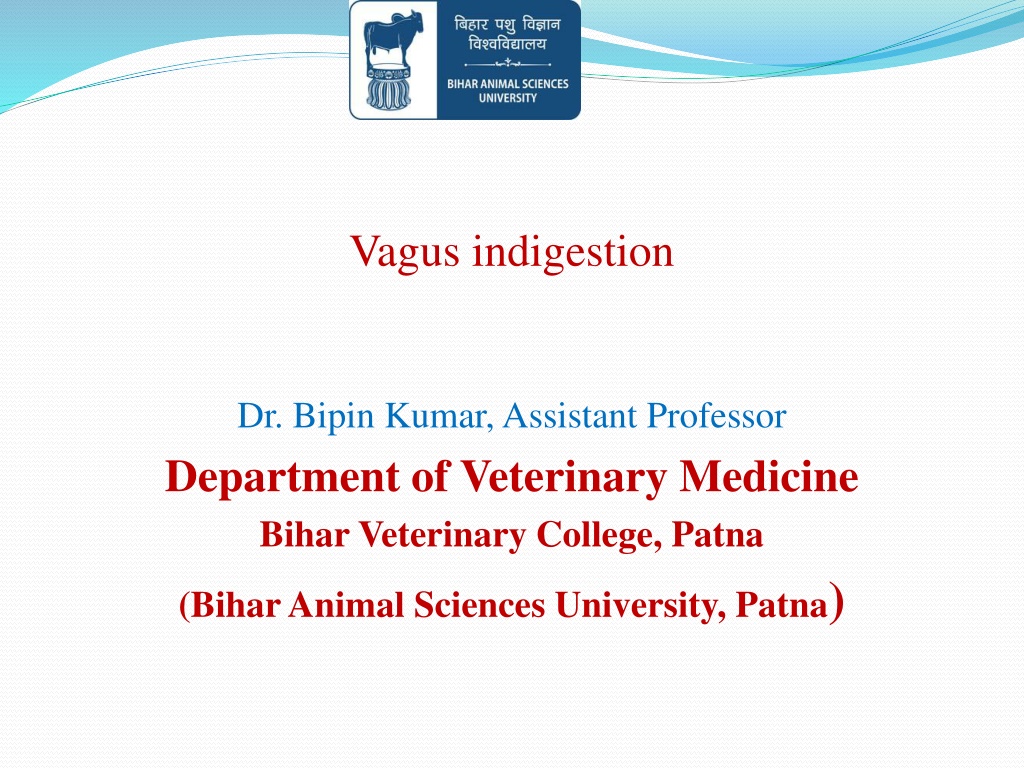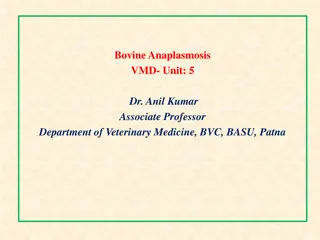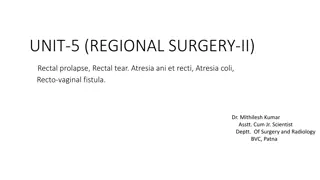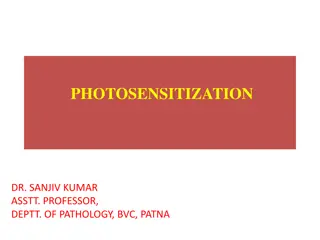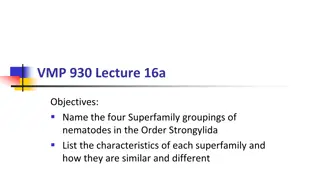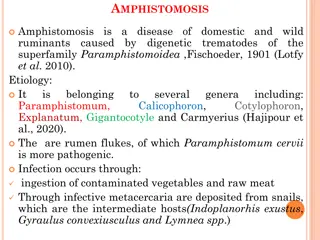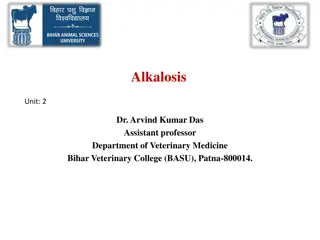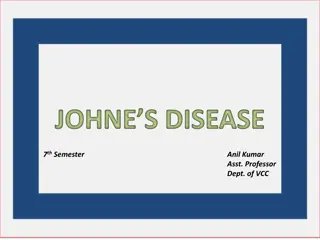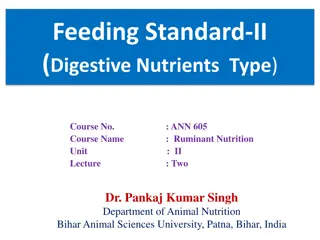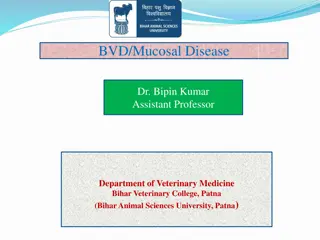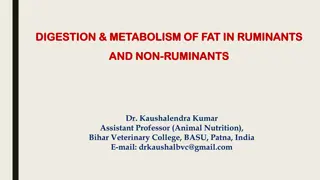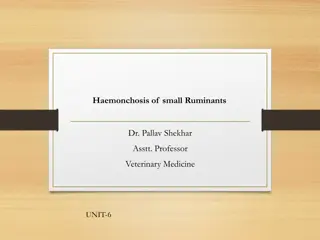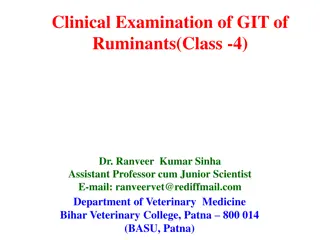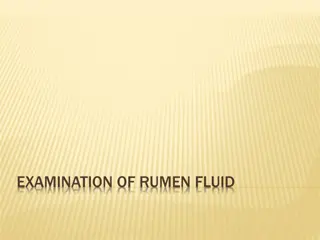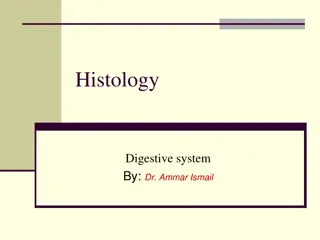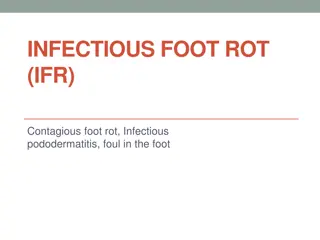Understanding Vagal Indigestion in Ruminants: Causes and Types
Vagal indigestion in ruminants is a functional disturbance affecting the fore stomachs, leading to symptoms like rumen distention, inappetence, bradycardia, and more. It is not a specific disease but a syndrome with various underlying causes such as injury, inflammation, or mechanical obstruction. The types of vagal indigestion are classified based on the site of functional obstruction, ranging from failure of eructation to abomasal impaction. Lesion sites determine clinical signs, with vagal neuritis or injury being common culprits.
Download Presentation

Please find below an Image/Link to download the presentation.
The content on the website is provided AS IS for your information and personal use only. It may not be sold, licensed, or shared on other websites without obtaining consent from the author. Download presentation by click this link. If you encounter any issues during the download, it is possible that the publisher has removed the file from their server.
E N D
Presentation Transcript
Vagus indigestion Dr. Bipin Kumar, Assistant Professor Department of Veterinary Medicine Bihar Veterinary College, Patna (Bihar Animal Sciences University, Patna)
Functional disturbance of the ruminants fore stomachs. Not one specific disease, this is a syndrome which causes rumen distention. Inappetance Bradycardia Hypermotility of rumen Paple shaped abdomen Scanty feces
Etiology Various diseases can cause vagal indigestion due to injury, inflammation, or pressure on the vagal nerve. However, conditions resulting in mechanical obstruction of the cardia or reticulo omasal orifice
TYPES OF VAGAL INDIGESTION Based on the site of the functional obstruction. Type I is failure of eructation or free gas bloat, Type II is a failure of omasal transport, Type III is abomasal impaction, Type IV is partial obstruction of the fore stomach.
TYPE I VAGAL INDIGESTION FREE GAS BLOAT - Partial esophageal obstruction due to foreign body or extra esophageal obstruction due to lymphosarcoma, thyroid tumors, lung abscess. FAILURE OF ERUCTATION - Inflammatory lesion adjacent to vagus nerve (localized peritonitis). TYPE II VAGAL INDIGESTION FAILURE OF OMASAL TRANSPORT due to Abscesses Lymphosarcoma, Papilloma, Squamous cell carcinoma, Large infarct, adhesions, Liver abscess exerting pressure of vagus.
TYPE III VAGAL INDIGESTION ABOMASAL IMPACTION ,Lack of water access PYLORIC STENOSIS/OBSTRUCTIONS Traumatic reticulo peritonitis Abscesses or adhesions Foreign body Vagal neuritis TYPE IV VAGAL INDIGESTION Most difficult type- uterus enlarges, abomasum pushed forward which interferes with normal motility. If going on for a long time it will progress into one of the other types.
PATHOPHYSIOLOGY Lesion site will determine the clinical signs Vagal neuritis or injury - due to traumatic reticuloperitonitis, space occupying lesions (tumors abscesses), or foreign body
CLINICAL SIGNS Bradycardia- slow heart beat or pulse Abdominal distention ,Anorexia, loss or decreased appetite Ruminal tympany An enlarged 'papple' shaped abdomen Scanty faeces with an increase in undigested particles or Absence of faeces (constipation) Hyper motility of rumen Inadequate response to treatment
Diagnosis CLINICAL PATHOLOGY Moderate neutrophilia and shift to the left Increased plasma protein concentrations.This may be indicative of a chronic reticuloperitonitis. Serum biochemistry , Metabolic hypochloremic, hypokalemic alkalosis. Ruminal chloride concentrations .These are normally below 30 mmol/L and increased in posterior stenosis to levels above 40 mmol/L due to abomasal reflux . Figure out what's in the rumen by palpation. Increase in rumen fluid with abdominal impaction- hypochloremic, hypokalemic metabolic alkalosis. Rectal palpation of rumen and other organs.
TREATMENT TYPE I Establish rumen fistula Purported antifermentatives- turpentine Type II Ruminatorics and cathartics- GI evacuation Ca gluconate i/v Need surgical correction Wont respond to symptomatic treatment Needle biopsy of mass Drain abscess Pass a stomach tube
TYPE III Vigorous thearpy- poor prognosis Salvage- recommended Oral cathartics, laxatives, metaclopramide calcium gluconate IV fluids Last alternative- abomasotomy- not beneficial. TYPE IV Indigestion of advanced pregnancy- IV fluids Decide what is more valuable- cow or calf. If within 4-6 weeks of parturition- symptomatic treatment
ATROPINE TEST Inj.Atropine sulphate 30 mg sc or 0.06mg/kg A rise in heart rate of more than 20 beats/mt in 10 minutes is suggestive of Vagal Indigestion DYE TEST To rule out Omasal Impaction in field condition Mix charcoal or innocuous dye with 2 litres of 10 % salt solution and drench, after 5 mts abomasocentesis is done ,absence of charcoal or dye --- omasal impaction Not Passing Dung .?? Rumen Impaction Intestinal Obstruction Intestinal Intussusceptions Paralytic ileus
